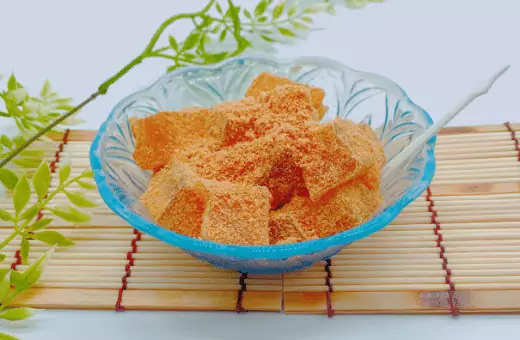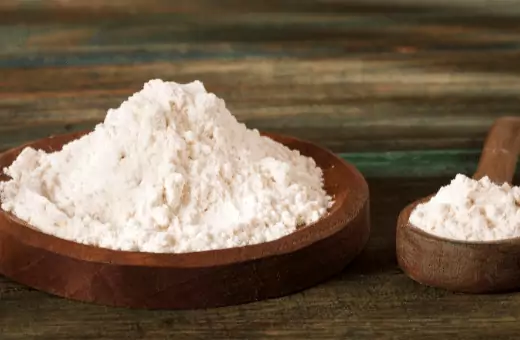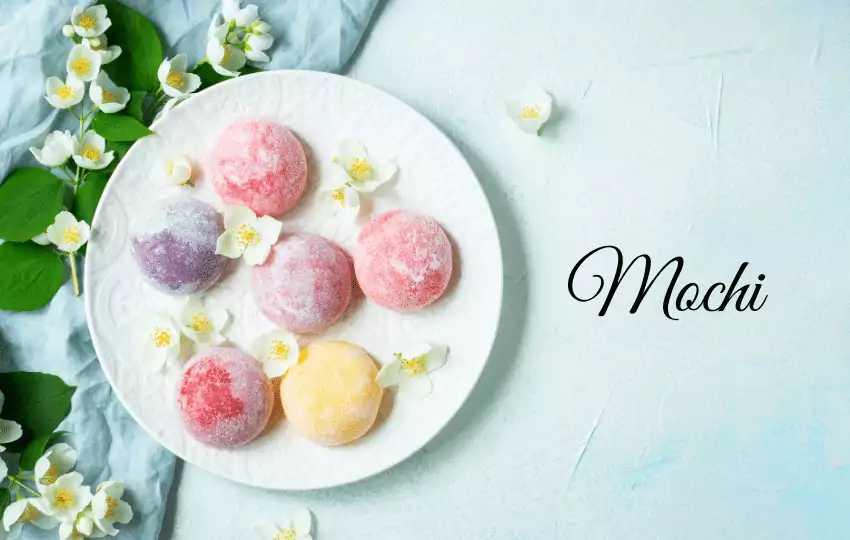Mochi is a famous rice cake in Japan and is often eaten in the new year. I’m sure you will like it if you haven’t tried before!
However, mochiko (glutinous rice flour) must be used for making Japanese mochi.
But what would happen if you didn’t have it? Never mind, I’ve got a solution for you, and it is a mochiko substitute for mochi.
What is Mochiko?
Mochiko is a Japanese rice flour that is made from short-grain white rice. It has a light, fluffy texture and a mild flavor, perfect for use in both savory and sweet dishes.
Mochiko utilizes versatility but is most commonly used to make mochi, a Japanese sweet rice cake. It can also be used to make dumplings, bread, and other baked goods, Manju, Dango, etc.
What does Japanese mochi taste like?
Mochi is a chewy, gummy food made from different ingredients depending on the recipe.
Some mochi recipes will call for mochiko, while others use a combination of glutinous rice flour and sweet rice flour.
The texture of the two types of mochi is very similar because both have a stretchy, chewy quality. The flavor of sweet mochi is usually a little sweeter than regular mochi.
Is mochiko the same as rice flour?
Yes, mochiko is a type of rice flour. However, Rice flour is made either from long-grain rice or short-grain white rice. Mochiko is made from short-grain white rice.
Mochiko is a common ingredient in Japanese cuisine and makes things like mochi and dumplings.
Rice flour can be made from any type of rice, Glutinous rice flour produces a more sticky dough, so it is better for making mochi, pancakes, and dumplings.
Non-glutinous rice flour yields a less sticky dough, so it is better for making bread and cakes.
8 Mochiko Substitute for Mochi
I only found eight substitutions for Mochiko to make mochi, like traditional mochi.
1. WARABIKO
Warabiko is a kind of jelly made from the starch extracted from the root of the Warabi plant.

The extracted starch is boiled and cooled down to make a jelly-like substance. It has a slightly rubbery texture and a sweet, nutty flavor.
Warabiko is often used in making mochi, as it gives the rice cake a slightly chewy texture and a sweet flavor. Whenever you are running Mochiko, use Warabiko to substitute for it.
Here is the simple recipe:
Ingredients:
· 1 cup glutinous rice
· 1/2 cup Warabiko
· 1/2 cup sugar
· 1 tsp soy sauce
· 1 1/4 cup water
Direction:
1. Wash the glutinous rice and drain.
2. In a pot, combine 1 1/4 cups of water, 1/2 cup warabiko, 1/2 cup sugar, and 2 tbsp soy sauce.
3. Bring to boil over high heat. When the liquid boils, turn down to medium-low heat and simmer for 5 minutes or so until it gets slightly sticky.
4. Add the glutinous rice into the pot and stir it continuously to prevent sticking on the bottom of the pot.
5. Stir until most of the liquid is absorbed, then cover with a lid and cook over low heat for 10 minutes.
6. Turn off the heat and let it sit for another 10 minutes to absorb the flavors.
7. Wipe the bottom of the saucepan with a moist cloth and shape the mochi on a dish.
Let’s rock with Warabiko Mochi!
2. SHIRATAMAKO
Shiratamako is a type of Japanese white rice flour often used to make sweets. It has a fine, delicate texture and a slightly sweet flavor, perfect for desserts.
Shiratamako can be found in most Japanese grocery stores, and it is also available online.
I have only used the Shiratamako for making Dango so far. However, it can be made into Mochi. But you have to be patient! It takes time and effort for this process!
We assume that you have tried making Kinako Mochi by mixing 1/2 water to 3/4 Shiratamako and microwaving it.
Ingredients:
· 1 cup of Shiratamako,
· 1/2 cup of sugar,
· 1 tablespoon of oil,
· 1 cup of water
Direction:
1. Combine the Shiratamako, sugar, oil, and water in a pot.
2. Cook, stirring constantly, over moderate flame until the mixture thickens and becomes sticky. This will take about 30 minutes.
3. Once it is thick, divide it into 12 pieces.
4. Wet your hands and press each piece into a ball. Then use a wooden mallet to shape them into mochi.
5. Be sure to wet the mallet before each hit! Finally, roll the mochi in Kinako to coat.
If you don’t want to go through all of that, there are ready-made mochi products available.
But they usually don’t have the same flavor or texture as ones made from scratch. So it’s definitely worth a try!
3. WATER, SUGAR & CORNSTARCH
Together with Water, Sugar and Cornstarch are the great mixtures to substitute for Mochiko in making Mochi. Moreover, It has a little different taste from the real mochi, you can try it.
All you have to do is- Ingredients:
· 1 cup water
· 3 tablespoons sugar
· 3 tablespoons cornstarch
Directions:
1. Combine the water and sugar in a small pot over medium heat. Stir until the sugar has dissolved.
2. Dissolve the cornstarch in a few tablespoons of water in a small bowl.
3. Add the cornstarch mixture into the pot little by little while continuing to stir until the mochi has reached desired thickness (if you want chewier mochi, add less; if you want softer mochi, add more).
4. Pour the mochi mixture onto a lightly greased surface (I used cooking spray) and let cool. Once cooled, cut into the desired shape and enjoy!
Note to remember:
· If the mochi mixture is too thick, add more water a little at a time until desired consistency is reached.
· For best results, let the mochi mixture rest for a few minutes before cutting into shape.
· For a sweetened version, add more sugar to taste.
· Be sure to grease the surface well, or the mochi will be difficult to remove.
As you can see, this recipe is very easy to make and doesn’t require any special ingredients.
So if you’re searching for a quick and simple way to make mochi, this is the recipe for you!
4. TAPIOCA FLOUR
Tapioca flour can be used to make mochi alternatives to Mochiko. Tapioca flour is a starchy flour that is made from the root of the cassava plant.

Tapioca flour has a neutral flavor and a slightly chewy texture. It is often used as a thickener or binder in recipes.
I tried making mochi using this type of mochiko last year.
First, I mixed an equal amount of sugar and salt with 2 cups of water in a pot and boiled it to get syrup.
Then, I poured the syrup into a big bowl and added 4 cups of tapioca flour.
I mixed everything well until the flour became sticky.
Finally, I made small balls from the mixture and boiled them in water for about 10 minutes. They turned out great!
5. JOSHINKO
Joshinko is a Japanese type of glutinous rice flour. It is a good alternative to mochiko for mochi.
Here I will show you how to make mochi using Joshinko (glutinous rice flour) instead of mochiko (rice flour).
Ingredients:
· 1 cup joshinko,
· 1 cup water,
· 3/4 cup sugar,
· a pinch of salt
Direction:
1. Combine the joshinko and water in a medium saucepan and stir to combine. Let the mixture sit powder for 30 minutes to allow the joshinko to absorb the water.
2. Put the saucepan over medium flame and constantly stir until the mixture thickens and becomes difficult to stir.
3. Add the sugar and salt and continue cooking and stirring until the mochi is very thick and sticky. It will start to come away from the sides of the pan.
4. Remove from heat and pour onto a non-stick surface (such as a silicone baking sheet or a piece of wax paper). Allow cooling for about 10 minutes until it’s cool enough to handle.
5. Cut into small pieces and enjoy! The mochi can be wrapped in plastic wrap and stored at room temperature for a few days or frozen for months.
Tricks to Keep Mochi for a Long Time: If you add 1/4 tsp vinegar to the water when making this mochi, it will keep longer (up to 2 weeks).
Before cooking, I added some green tea powder and matcha powder into the mochi mixture and made daifuku with red bean paste. It was really delicious!
6.MILK+POTATO STARCH
You can use Milk and potato starch to make mochi without mochiko. The resulting mochi will be a bit harder and less fluffy than mochiko, but it will still taste delicious! Give it a try!
7. DANGO FLOUR
Dango Flour is a great substitute for Mochiko. It is a type of wheat flour made from grinding Dango, a traditional Japanese sweet made from rice flour.
Dango flour has a slightly sweet flavor and a fine, powdery texture. It is available in most Asian markets.
So, you can use dango flour to make mochi without mochiko.
Dango flour is made from ground Dango, which has a similar consistency to mochiko. It can be used in the same recipes.
However, Dango flour is not as finely ground as mochiko, so it will not produce as smooth a texture.
If you want to use dango flour to make mochi, you may need to add a little extra water to make the dough more pliable.
8. RICE+ POTATO STARCH
Another way once I have tried that is rice and potato starch mixture. You can substitute potato starch for some or all of the rice flour in mochi dough.
The dough will be slightly stickier, but it will still work. Just be sure to add enough flour to keep the dough from sticking to your hands or the work surface.
Making mochi is a multi-step process involving cooking, mixing, shaping into balls or other shapes, and steaming.
If you are new to making mochi at home, I suggest starting with my mochiko flour recipe.
It has complete instructions for making the dough from scratch, including photos to show how it should look at each stage.
Making mochi from scratch takes a little more time and effort, but it’s worth it!
So these are the mochiko substitutes you can use to make mochi while you don’t have an option.
Cooking is an art, and you always do experiments with it. Sometimes, you get surprising yet amazing results even though they failed.
But don’t worry, always do something new with recipes.
Is mochiko cooked?
The answer to this question isn’t as straightforward as you might think.
Technically, mochiko isn’t cooked since it’s a type of flour. However, some people choose to cook it before using it in recipes.
If you’re looking for a quick and easy way to make mochiko pancakes or waffles, cooking the flour beforehand is a good option.
Just combine mochiko with some water, oil, and/or eggs, then cook it in a pan or waffle iron.
On the other hand, if you’re using mochiko in a savory dish, you may not want to cook it beforehand.
In this case, you can just add the flour to your recipe as is.
No matter what you’re using mochiko for, it’s a good idea to start with a small test batch before making a large batch.
This will help you decide whether you need to cook the flour ahead of time.
Is mochi rice the same as glutinous rice?
Mochi rice is a short-grain Japanese rice that is sticky when cooked. It has a distinctively strong fragrance and flavor.
Mochi can be used for savory and sweet dishes, such as the well-known mochi ice cream.
It is not to be confused with ‘glutinous’ or ‘sticky’ rice, which is long grain rice.
Read More- 10+ Arborio rice Alternative to use various recipe
My All-time preferable Mochiko Substitute for Mochi
My all-time favorite Mochiko Substitute for Mochi are
· Dango Flour
· Warabiko
· Water, Sugar, and Cornstarch
· Joshinko
Wrap Up on Substitute for Mochiko in Mochi
It is evident that there are many substitutes for mochiko flour. It is easy to find a replacement that will work for your needs with so many options.
Whether you are looking for a gluten-free option or something easier to digest, there is sure to be a substitute that will work well for you.
Be sure to do your research to find the best option for your needs.
FAQs Related to Mochiko- Mochi & Its Alternatives
Q1. What is the difference between salted and sweet mochi?
Salted mochi (shio-Kinton) is made by pressing cooked glutinous rice into round shapes to which salt has been added.
Sweet mochi (Sato-Kinton) uses an equal mixture of sugar and adzuki red beans, then folded into the cooked rice.
Q2. Is mochi made with white rice?
Mochi can be made with other grains like barley or millet. Still, it is most commonly made with Japanese glutinous (sticky) rice (mochigome).
Q3. What is the difference between daifuku and mochi?
Daifuku is a soft, sweet cake made of a thin layer of red bean center wrapped in a thin layer of white mochi.
Both are made from rice, but mochi contains no filling. Daifuku may also have other kinds of filling.
Q4. What is mochi-gome?
Mochi-gome also called glutinous rice or sweet rice, is a type of short-grain Japanese rice used to make mochi and other confectioneries.
Mochi-gome has a nutty flavor and sticky texture when cooked. It can be found in most Japanese or Asian markets.

